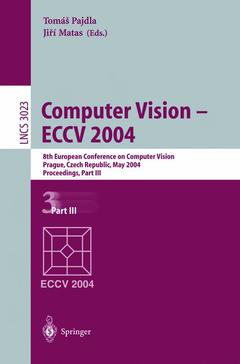Description
Computer Vision - ECCV 2004, 2004
8th European Conference on Computer Vision, Prague, Czech Republic, May 11-14, 2004. Proceedings, Part III
Coll. Lecture Notes in Computer Science, Vol. 3023
Coordinators: Pajdla Tomas, Matas Jiri
Language: French
Publication date: 04-2004
614 p. · 15.5x23.5 cm · Paperback
614 p. · 15.5x23.5 cm · Paperback
Description
/li>Contents
/li>Comment
/li>
Welcome to the proceedings of the 8th European Conference on Computer - sion! Following a very successful ECCV 2002, the response to our call for papers was almost equally strong ? 555 papers were submitted. We accepted 41 papers for oral and 149 papers for poster presentation. Several innovations were introduced into the review process. First, the n- ber of program committee members was increased to reduce their review load. We managed to assign to program committee members no more than 12 papers. Second, we adopted a paper ranking system. Program committee members were asked to rank all the papers assigned to them, even those that were reviewed by additional reviewers. Third, we allowed authors to respond to the reviews consolidated in a discussion involving the area chair and the reviewers. Fourth, thereports,thereviews,andtheresponsesweremadeavailabletotheauthorsas well as to the program committee members. Our aim was to provide the authors with maximal feedback and to let the program committee members know how authors reacted to their reviews and how their reviews were or were not re?ected in the ?nal decision. Finally, we reduced the length of reviewed papers from 15 to 12 pages. ThepreparationofECCV2004wentsmoothlythankstothee?ortsofthe- ganizing committee, the area chairs, the program committee, and the reviewers. We are indebted to Anders Heyden, Mads Nielsen, and Henrik J. Nielsen for passing on ECCV traditions and to Dominique Asselineau from ENST/TSI who kindly provided his GestRFIA conference software. We thank Jan-Olof Eklundh and Andrew Zisserman for encouraging us to organize ECCV 2004 in Prague.
Learning and Recognition.- A Constrained Semi-supervised Learning Approach to Data Association.- Learning Mixtures of Weighted Tree-Unions by Minimizing Description Length.- Decision Theoretic Modeling of Human Facial Displays.- Kernel Feature Selection with Side Data Using a Spectral Approach.- Tracking II.- Tracking Articulated Motion Using a Mixture of Autoregressive Models.- Novel Skeletal Representation for Articulated Creatures.- An Accuracy Certified Augmented Reality System for Therapy Guidance.- Posters III.- 3D Human Body Tracking Using Deterministic Temporal Motion Models.- Robust Fitting by Adaptive-Scale Residual Consensus.- Causal Camera Motion Estimation by Condensation and Robust Statistics Distance Measures.- An Adaptive Window Approach for Image Smoothing and Structures Preserving.- Extraction of Semantic Dynamic Content from Videos with Probabilistic Motion Models.- Are Iterations and Curvature Useful for Tensor Voting?.- A Feature-Based Approach for Determining Dense Long Range Correspondences.- Combining Geometric- and View-Based Approaches for Articulated Pose Estimation.- Shape Matching and Recognition – Using Generative Models and Informative Features.- Generalized Histogram: Empirical Optimization of Low Dimensional Features for Image Matching.- Recognizing Objects in Range Data Using Regional Point Descriptors.- Shape Reconstruction from 3D and 2D Data Using PDE-Based Deformable Surfaces.- Structure and Motion Problems for Multiple Rigidly Moving Cameras.- Detection and Tracking Scheme for Line Scratch Removal in an Image Sequence.- Color Constancy Using Local Color Shifts.- Image Anisotropic Diffusion Based on Gradient Vector Flow Fields.- Optimal Importance Sampling for Tracking in Image Sequences: Application to Point Tracking.- Learning to Segment.- MCMC-Based Multiview Reconstruction of Piecewise Smooth Subdivision Curves with a Variable Number of Control Points.- Bayesian Correction of Image Intensity with Spatial Consideration.- Stretching Bayesian Learning in the Relevance Feedback of Image Retrieval.- Real-Time Tracking of Multiple Skin-Colored Objects with a Possibly Moving Camera.- Evaluation of Image Fusion Performance with Visible Differences.- An Information-Based Measure for Grouping Quality.- Bias in Shape Estimation.- Contrast Marginalised Gradient Template Matching.- The Kullback-Leibler Kernel as a Framework for Discriminant and Localized Representations for Visual Recognition.- Partial Object Matching with Shapeme Histograms.- Modeling and Synthesis of Facial Motion Driven by Speech.- Recovering Local Shape of a Mirror Surface from Reflection of a Regular Grid.- Structure of Applicable Surfaces from Single Views.- Joint Bayes Filter: A Hybrid Tracker for Non-rigid Hand Motion Recognition.- Iso-disparity Surfaces for General Stereo Configurations.- Camera Calibration with Two Arbitrary Coplanar Circles.- Reconstruction of 3-D Symmetric Curves from Perspective Images without Discrete Features.- A Topology Preserving Non-rigid Registration Method Using a Symmetric Similarity Function-Application to 3-D Brain Images.- A Correlation-Based Approach to Robust Point Set Registration.- Hierarchical Organization of Shapes for Efficient Retrieval.- Information-Based Image Processing.- Intrinsic Images by Entropy Minimization.- Image Similarity Using Mutual Information of Regions.
Includes supplementary material: sn.pub/extras
© 2024 LAVOISIER S.A.S.




